Oslyabya vs. Mikasa
So, according to Vladimir Kofman, the winner of the Tsushima battle was determined.
How did the Japanese decide the outcome of the battle so quickly? This is one of the key Tsushima issues. To get to the answer to it, we will be helped by an analysis of the ratio of the fire impact of the Russian and Japanese fleets in the setting of the Tsushima battle on the example of ships that concentrated the most intense fire. This is Mikasa among the Japanese and Oslyabya among the Russians. Yes Yes! I was not mistaken, it was Oslyabya, not Prince Suvorov, and I will prove it.
As a criterion for assessing the impact of fire, I use the number and caliber of missiles hit (projectiles with a caliber of 76 mm or less will not be counted as incapable of causing significant damage). The issue of the quality of shells will be left outside the article. The chronological framework is from the moment of opening fire until the Oslyaby’s failure (14:20 and 14:40: given Russian time and Japanese. For Tsushima, the time difference was 20 minutes). It makes no sense to use a longer period, because, firstly, the fate of Oslyaby was already decided by that time, and secondly, many Japanese ships moved the fire to other targets.
Is it really Oslyabya that has undergone the most intense fire exposure? To answer this question, let's look at the Japanese scheme of firing in the Tsushima battle, which indicates: the target, the time of firing and the distance on the rangefinder at that time (there are obvious errors in determining the distance). Seven warships, including two battleships, launched their fire on the Oslyabya as the closest or most convenient target (its Japanese ships determined themselves). The fact is that at the time of the opening of fire the restructuring of the Russian squadron in one line had not yet been completed and Oslyabya was at the head of the left column closest to the enemy under the flag of Rear Admiral Felkersam.
If you look at the distribution of goals in Japanese fleet after the opening of fire, even the moment will be discovered when the Oslyabya was in the sights of eight ships at the same time! For clarity, the data were summarized by Vladimir Sidorenko (for which special thanks to him) to the schedule.
Now we can begin to assess the fire impact, that is, try to calculate the number and caliber of shells that have reached Oslyaby.
First, we will examine eyewitness accounts. Michman Shcherbachev from the “Eagle” after some 10-15 minutes of the battle already observed only 10-15 large holes in the Oslyaby’s nose. Impressive numbers! If, looking at the silhouette and the reservation scheme, we assume that the shells hit not only the nose and did not always leave holes (if they hit the armor), then the total number of shells can be estimated at 30-45 or even more. But the reliability of this assumption, we will leave a big question, since Shcherbachev’s testimony could well have been distorted by the extremely emotional impressions of the battle.
Then we will try another way: we systematize specific hits that eyewitnesses mentioned in the records (which is more valuable), or which were mentioned from the words of other persons. We begin to list the damage from the bow to the stern, as their chronology cannot be established. By default, we mean the left side.
1. Living deck near the bow bulkhead. This hit was colorfully described by Novikov-Priboy: “The third shell hit the armadillo in the bow and, tearing out the left clue entirely, turned the entire tank. An anchor fell overboard, and the rope was etched down and hung on a gibacal brace. ” Some of the bow compartments were flooded, but this hole, according to the mine-machine conductor Zavarin and senior mine officer Sablin, was closed up and did not pose a danger. With a high probability, it was a 305 mm shell.
2. The bow tower. According to Sablin's testimony, three shells hit the tower in succession. Zavarin, who personally saw damage to the bow tower, estimates the caliber of at least one of the shells at 305 mm.
3. Bow cutting. According to Novikov-Surf - two hits. The upper bridge was destroyed, fragments penetrated the conning tower, a fire broke out, which is confirmed by eyewitnesses.
4. The nasal casemate of 152 mm guns. Two shells. The first did no harm, but the second shifted the armor plate and knocked the gun out of the pins.
5. 75 mm battery. Three hits, according to the testimony of Lieutenant Kolokoltsev.
6. The average casemate of 152 mm guns.
7. The tenth coal pit. Interestingly, as a result of the hit, the water flooded another spare kruyt-chamber located on the lower deck and protected, except for the armored belt, also with the armored deck. Such penetrating damage can only be explained by the successive hit in one place of two shells, one of which was 305 mm.
8. The mainsail.
9. Gafel.
For convenience, I numbered the damage locations on the ship diagram.
Apparently, there were also fatal holes for the Oslyaby, which caused extensive flooding of the bow inside the citadel, but of which Sablin and Zavarin did not know. Many sources noted a large trim "Oslyaby" on the nose. This is most expressively described by Shcherbachev:
Flooding of the bow compartments from getting into the living deck near the bow bulkhead could not cause such a strong trim due to the insignificance of the flooded volume. Flooding as a result of falling into the tenth coal pit (and this is between the third pipe and the main mast!), On the contrary, would reduce the trim on the nose. It turns out that diving to the level of clushes can be explained only by the presence of significant flooding of the bow, in addition to those listed by Sablin and Zavarin. Moreover, flooding even of all volumes outside the citadel will not be enough for this.
And how can one not recall the very vivid, but at the same time extremely dubious descriptions of a huge hole in the board, "a real gate where you could drive in the top three." Doubtful - because those who were not on the Oslyab and were unlikely to see it themselves write about this hole; and, in addition, there is no clear localization of this hole. The flagship navigator of the Semyonov squadron has it in the forward unarmored part, which has something in common with getting into a residential deck near the bow bulkhead. Novikov-Priboy points to a very long gap between the mine apparatus and the bathhouse, that is, in the area of the second or third pipe and reports of fallen armored plates, which have a certain similarity with falling into the tenth pit, which was just in the area of the bathhouse. The senior officer of the Orla Schwede saw the absence of one or two plates of the upper belt and the hole in their place, but did not indicate specifically where. Ozerov, the commander of Sisoy the Great, localized the place where there was no armor plate opposite the front bridge (I note that there is no upper belt in this place).
But back to our confirmed hits, which turned out to be 16, of which 3 are supposedly 305 mm. At the same time, the numerous damage to the deck and the unarmored side described by the witnesses, as well as hits that caused fires on the rosters and in the stern, were not taken into account. In addition, the facts of very close shell explosions are striking, which is possible only with a very large total number of hits. Thus, the systematization of specific injuries rather confirms an estimate of 30-45 hits than disproves it.
Now let us check our assessment with Japanese data: is it real in terms of the actual fire impact of Japanese ships. We calculate how many shells should have been hit based on the number of shells fired. We already know what ships and what time fired at the Oslyab. But to calculate the number of shells, you need to know the actual rate of fire. Let's make a calculation.
Assumptions and limitations:
1. The duration of participation in the battle on May 14 is 180 minutes for the Togo squad and 150 minutes for the Kamimura squad.
2. The rate of fire is uniform throughout the battle.
3. The cruiser “Asama” will be excluded from the calculation, because due to failure the projectile consumption is almost two times lower than that of other ships.
4. If possible, we use the data on the consumption of shells only for May 14, but for individual ships there is only data for two days of the battle and we have to put up with this.
5. For 305 mm guns, we calculate the flow rate taking into account the failure of the guns, for the rest - excluding the failure of the guns.
6. We assume that the fire was fired by all the main caliber guns and half the medium caliber guns (one side).
7. Data on a specific caliber averaged for all ships. In fact, there were rather strong deviations, for example, "Sikishima" shot 12-inch shells slower than all (0,10 shells per minute), but 6-inch faster than all (1,10 shells per minute).
An example of calculating the actual rate of fire of the main caliber "Mikas". Two barrels acted for 180 minutes, one barrel - 110 minutes, another - 145 minutes. Consumption - 124 shells in 2 days. 124 / (180 + 180 + 110 + 145) = 0,2 rounds per minute per barrel.
As a result, the following average values of the actual rate of fire were obtained:
305 mm: 0,16 rounds per minute.
254 mm: 0,26 rounds per minute.
203 mm: 0,27 rounds per minute.
152 mm: 0,75 rounds per minute.
Now everything is ready for calculating the fire impact, except for accuracy. First, suppose that the accuracy of the Japanese fire in the Tsushima set could not be worse than in the Yellow Sea, that is, 10% for 305 mm, 4% for 203 mm and 1,5% for 152 mm (in total for 203 mm and 152 mm will be 1,8%, and the superiority in accuracy of 203 mm guns by almost 3 times over 152 mm is confirmed by the statistics of the battle in Chemulpo). We exclude 254-mm shells from the calculation, since at reasonable ratios not a single shell should have hit the target. Thus, if the Japanese in Tsushima fired with the same accuracy as in the Yellow Sea, then Oslyabya would receive 2-3 hits of 305 mm, 5 hits of 203 mm and 12 hits of 152 mm. Total 19-20 hits. Not much! This does not agree with the picture of the destruction of the ship, recorded by eyewitnesses.
But we did not take into account the objective factors affecting the accuracy of the Japanese. These are full commandors and serviceable devices (the beginning of the battle), this is a noticeably shorter battle distance in Tsushima, and this is accumulated experience. Is it possible to accept that these factors allowed the Japanese to be 1,5 times more accurate than in the Yellow Sea and thus reach at least 30 hits - the minimum of the estimated values? I think you can! Then we get 4 hits of 305 mm, 8 hits of 203 mm and 18 hits of 152 mm. Taking into account the fact that Oslyabya was fired upon by the Japanese even after 14:20 (14:40), right up to the moment when it was lying with the keel up, our data turn out to be close to Vladimir Gribovsky’s estimate (40 hits). Thus, it turns out to find a compromise between the picture described by Shcherbachev and the hits recorded by other sources on the one hand, and the sane data on the accuracy of Japanese fire on the other. But this assessment in no case can claim to be highly accurate, because it contains many assumptions and assumptions.
With Mikasa, however, everything is much simpler, since all data on the fire exposure are available. The chronology of hits up to 14:20 (14:40) according to the report of the ship's commander is given below.
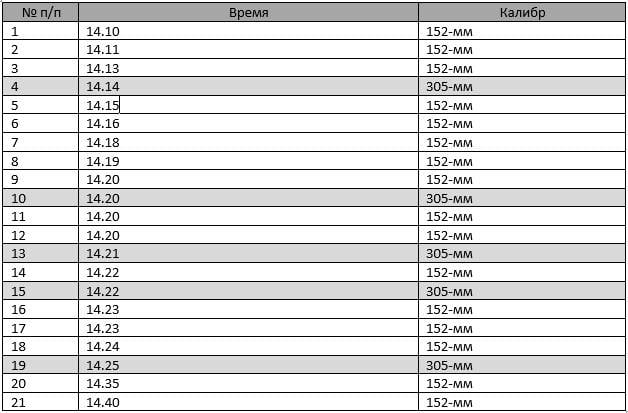
Only 5 hits 305 mm and 16 hits 152 mm.
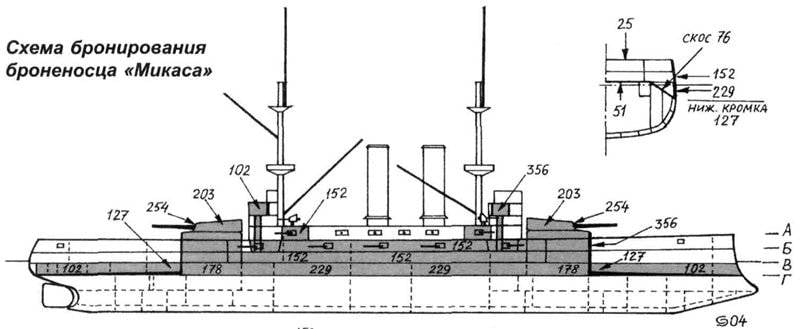
Now you can summarize. The Japanese fire on the Oslyabyu most likely exceeded the Russian fire on the Mikasu, or in extreme cases roughly corresponded to it. Given that the Mikasa was larger and had a much more powerful reservation than Oslyabya, it required much more hits to inflict critical damage on it than it actually received in the beginning of the battle. And Oslyabya would surely have lasted much longer in the battle if it had not had fatal construction flaws in the form of a huge overload and weak fixing of armor plates.
It should not be forgotten that, in addition to Oslyaby, the Prince of Suvorov, Alexander III, and Borodino, judging by the damage, received a completely comparable fire effect. In fact, the most combat-ready ships of the Russian squadron that could fire at Mikasa were suppressed. On the Japanese side, only the Asama cruiser, which temporarily lost a place in the ranks due to damage to the steering gear, received noticeable damage, except for the Mikasa. Thus, it can be stated that one of the instruments for the victory of the Japanese in the Tsushima battle was a significantly more powerful fire effect in the beginning of the battle, that is, an absolute superiority in the number of shells that hit the enemy.
Sources of
Fleet actions. Documents. Division IV. 2nd Pacific Squadron. The third book. The battle of May 14-15, 1905.
Novikov-Surf A. Tsushima.
Semenov V.I. Reckoning.
Gribovsky V. Yu. Russian fleet of the Pacific Ocean. 1898-1905. History creation and death.
Peasants V. Ya., Molodtsov S. V. Armadillos of the “Relight” type.
Melnikov R. M. Armadillos of the Peresvet type.
Kofman V. L. Tsushima: analysis against myths.
sidorenko-vl.livejournal.com
naval-manual.livejournal.com
tsushima.su
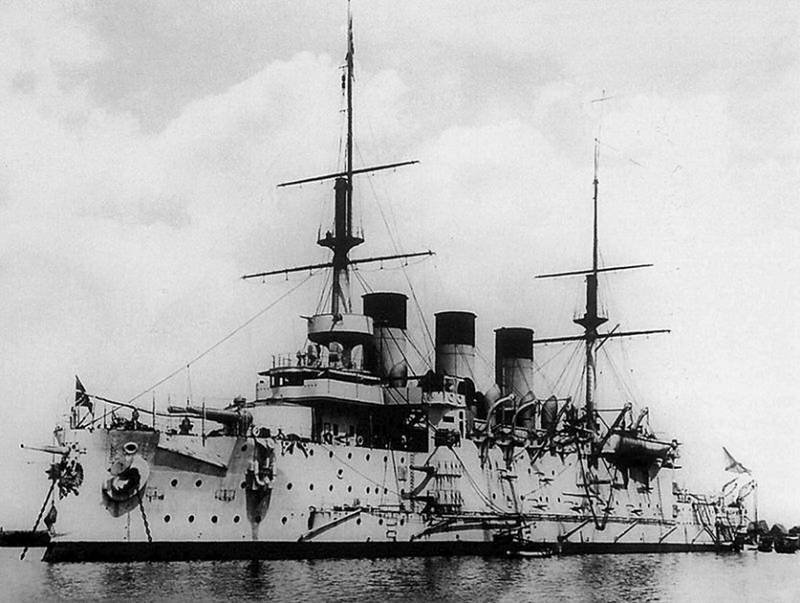
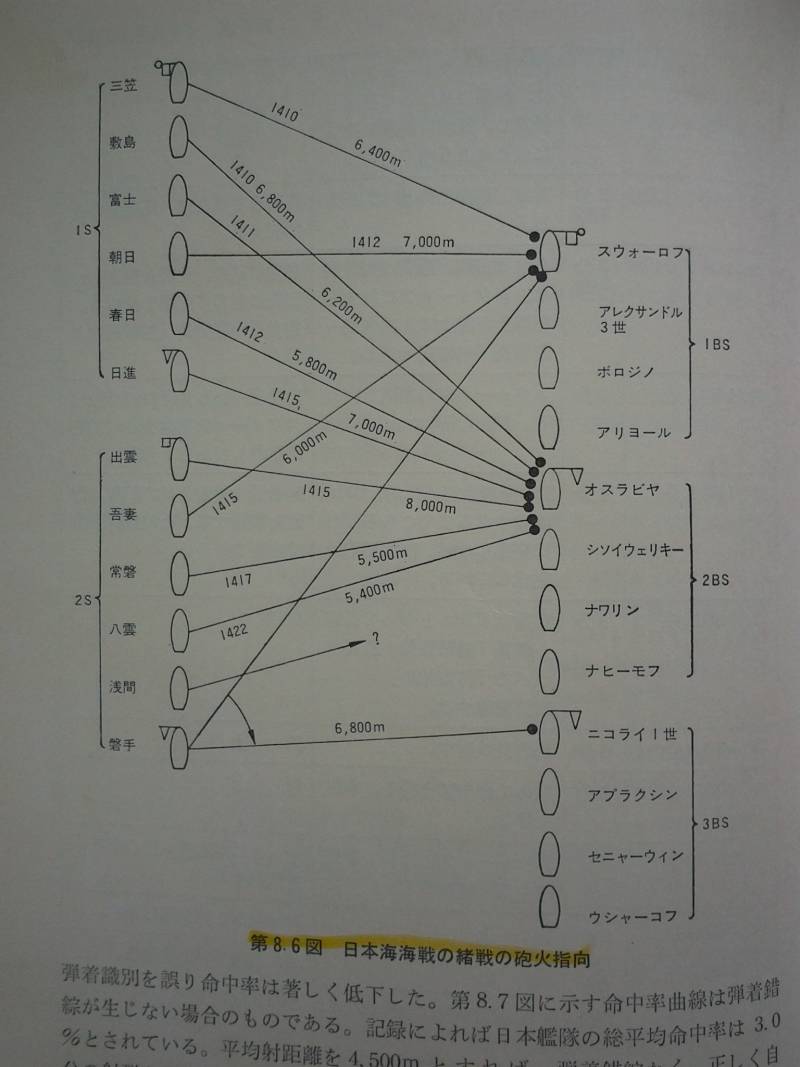
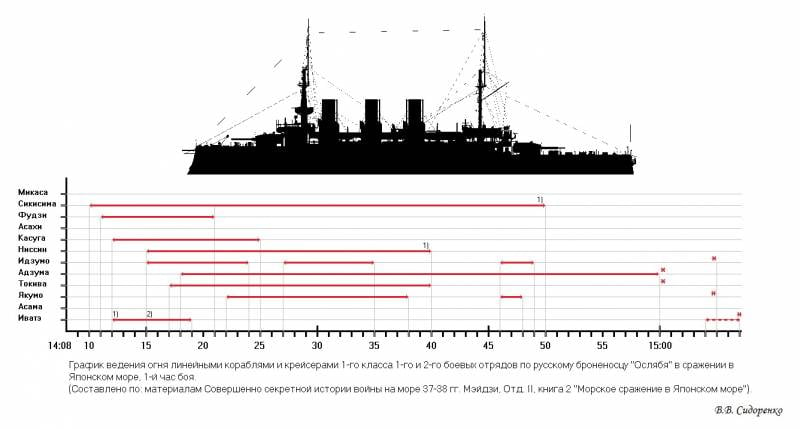
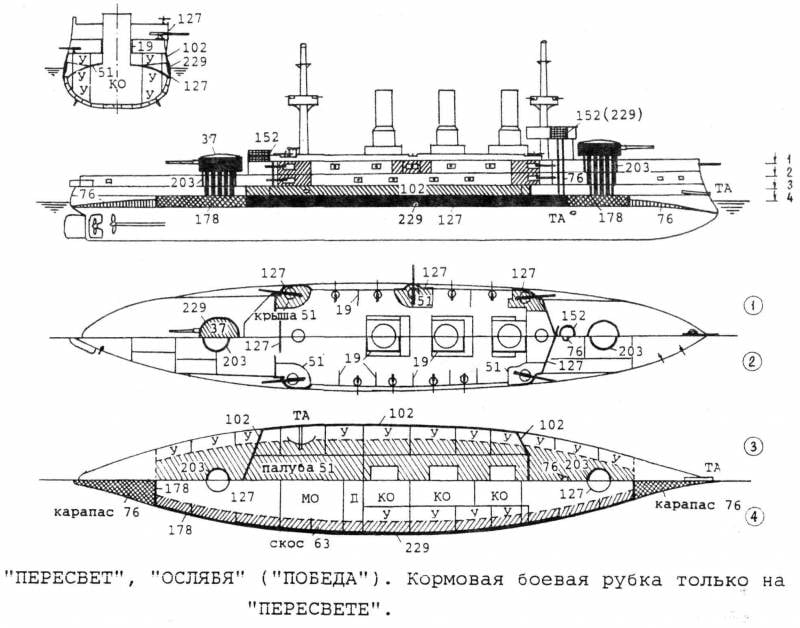
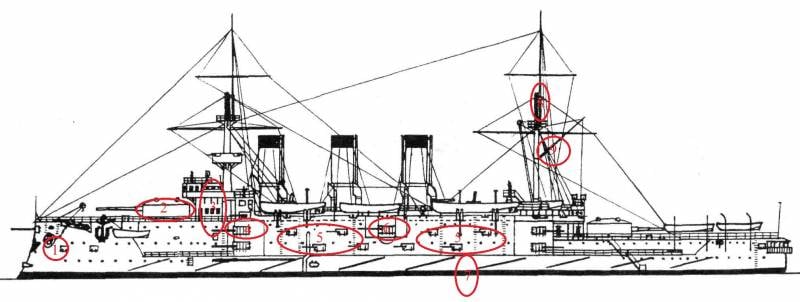

Information